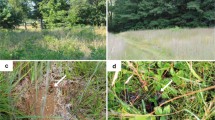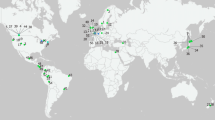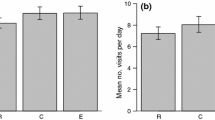Abstract
This paper questions whether bumblebees really forage as close to their nests as has commonly been assumed in the bumblebee literature. Three experiments are described that involved marking and reobservation bumblebees. None of these experiments showed any tendency for bumblebees to concentrate their foraging close to (e.g., within 50 m from) the nest. Rather, the results suggested that bumblebees may prefer to forage at some distance from their nest. Further, a closer review of the bumblebee literature showed that similar findings were quite common. Some possible explanations to the observed behavior patterns are given as outlines for further research.
Similar content being viewed by others
References
Alford, D. V. (1975).Bumblebees, Davis-Poynter, London.
Awram, W. J. (1970).Flight Route Behaviour of Bumblebees, Ph.D. thesis, University of London, London.
Banaszak, J. (1980). Studies on methods of censusing the numbers of bees (Hymenoptera: Apoidea).Pol. Ecol. Stud. 6: 355–366.
Bergwall, H. E. (1970). Ekologiska iaktagelser över några humlearter (Bombus Latr.) vid Staloluokta inom Padjelanta nationalpark, Lule Lappmark.Entomol. Tidskr..91: 3–23.
Beutler, R. (1951). Time and distance in the life of the foraging bee.Bee World 32: 25–27.
Bond, D. A., and Pope, M. (1974). Factors affecting the proportions of cross-bred and selfed seed obtained from field bean (Vicia faba L.) crops.J. Agr. Sci. 83: 343–351.
Bowers, M. A. (1985). Bumblebee colonization, extinction and reproduction in subalpine meadows in northeastern Utah.Ecology 66: 914–927.
Braan, A. D. (1954). The foraging of bumble bees.Bee World 35: 61–67, 81–91.
Brian, M. V. (1965).Social Insect Populations, Academic Press, London.
Broyles, S. B., and Wyatt, R. (1991). Effective pollen dispersal in a natural population ofAsclepias exaltata: The influence of pollinator behavior, genetic similarity, and mating success.Am. Nat. 138: 1239–1249.
Butler, C. G. (1951). Annual Report, Bee Department, Rothampstead Experimental Station.
Cartar, R. V., and Dill, L. M. (1990). Colony energy requirements affect the foraging currency of bumble bees.Behav. Ecol. Sociobiol. 27: 377–383.
Corbet, S. A., Kerslake, C. J. C., Brown, D., and Morland, N. E. (1984). Can bees select nectarrich flowers in a patch?J. Apic. Res. 23: 234–242.
Corbet, S. A., Williams, I. H., and Osborne, J. L. (1991). Bees and the pollination of crops and wild flowers in the European community.Bee World 72: 47–59.
Coville, F. V. (1890). Notes on bumblebees.Proc. Entomol. Soc. Wash. 1: 197–203.
Eckert, J. E. (1955). The flight of the honeybee.Am. Bee J. 95: 395–401.
Eickwort, G. C., and Ginsberg, H. S. (1980). Foraging and mating behavior in Apoidea.Annu. Rev. Entomol. 25: 421–446.
Free, J. B. (1968). The foraging behavior of honeybees (Apis mellifera) and bumblebees (Bombus spp.) on blackcurrant (Ribes nigrum), raspberry (Rubus idaeus) and strawberry (Fragaria× ananassa) flowers.J. Appl. Ecol. 5: 157–168.
Free, J. B. (1970a). The flower constancy of bumblebees.J. Anim. Ecol. 39: 395–402.
Free, J. B. (1970b).Insect Pollination of Crops, Academic Press, New York.
Free, J. B. (1982)Bees and Mankind, George Allen & Unwin, London.
Free, J. B., and Butler, C. G. (1959).Bumblebees, Collins, London.
Gentry, A. H. (1978). Anti-pollinators for mass-flowering plants?Biotropica 10: 68–69.
Goldblatt, J. W., and Fell, R. D. (1987). Adult longevity of workers of the bumble beesBombus fervidus (F.) andBombus pennsylvanicus (De Geer) (Hymenoptera: Apidae).Can. J. Zool. 65: 2349–2353.
Handel, S. N. (1983). Pollination ecology, plant population structure, and gene flow. In Real, L. (ed.),Pollination Biology, Academic Press, pp. 163–211.
Harder, L. D. (1986). Influences on the density and dispersion of bumble bee nests (Hymenoptera: Apidae).Holarct. Ecol. 9: 99–103.
Heggenes, J., Krog, O. M. W., Lindås, O. R., Dokk, J. G., and Bremnes, T. (1993). Homostatic behavioural responses in a changing environment: Brown trout (Salmo trutta) become nocturnal during winter.J. Anim. Ecol. 62: 295–308.
Heinrich, B. (1975). Energetics of pollination.Annu. Rev. Ecol. Syst. 6: 139–170.
Heinrich, B. (1976a). The foraging specializations of individual bumblebees.Ecol. Monogr. 46: 105–128.
Heinrich, B. (1976b). Resource partitioning among some eusocial insects: Bumblebees.Ecology 57: 874–889.
Heinrich, B. (1979a). “Majoring” and “minoring” by foraging bumblebees,Bombus vagans: An experimental analysis.Ecology 60: 245–255.
Heinrich, B. (1979b).Bumblebee Economics, Harvard University Press, Cambridge, MA.
Hobbs, G. A., Nummi, W. O., and Visrostek, J. F. (1961). Food-gathering behaviour of honey, bumble and leaf-cutter bees (Hymenoptera: Apoidea) in Alberta.Can. Entomol. 93: 409–419.
Hodges, C. M. (1985). Bumble bee foraging: Energetic consequences of using a threshold departure rule.Ecology 66: 188–197.
Holm, S. N. (1966). The utilization and management of bumble bees for red clover and alfalfa seed production.Annu. Rev. Entomol. 11: 155–182.
Holmes, F. O. (1964). The distribution of honey bees and bumblebees on nectar-secreting plants.Am. Bee J. 104: 12–13.
Inouye, D. (1978). Response partitioning in bumblebees: Experimental studies in foraging behavior.Ecology 59: 672–678.
Jennersten, O., Berg, L., and Lehman, C. (1988). Phenological differences in pollinator visitation, pollen deposition and seed set in the sticky catchfly,Viscaria vulgaris.J. Ecol. 76: 1111–1132.
Kevan, P. G. (1975). Pollination and environmental conservation.Environ. Conserv. 2: 293–298.
Kevan, P. G., and Baker, H. G. (1983). Insects as flower visitors and pollinators.Annu. Rev. Entomol. 28: 407–453.
Kwak, M. M. (1978). Pollination, hybridization and ethological isolation ofRhinanthus minor andR. serotinus by bumblebees.Taxon 27: 145–158.
Kwak, M. M. (1979). Effects of bumble bee visits on the seed set of Pedicularis, Rhinanthus and Melampyrum (Schrophulariaceae) in the Netherlands.Acta Bot. Neerl. 28: 177–195.
Kwak, M. M. (1987). Marking a bumblebee without anaesthesia.Bee World 68: 180–181.
Kwak, M. M., Kremer, P., Boerrichter, E., and van den Brand, C. (1991). Pollination of the rare speciesPhyteuma nigrum (Campanulaceae): Flight distances of bumblebees.Proc. Exp. Appl. Entomol. 2: 131–136.
Levin, D. A. (1981). Dispersal versus gene flow in plants.Ann. Mo. Bot. Gard. 68: 233–253.
Levin, D. A., and Kerster, H. W. (1974). Gene flow in seed plants.Evol. Biol. 7: 139–220.
Liu, H. J., Macfarlane, R. P., and Pengelly, D. H. (1975). Relationships between flowering plants and four species ofBombus (Hymenoptera: Apidae) in southern Ontario.Can. Entomol. 107: 577–588.
Løken, A. (1985). Norske insekttabeller. 9. Humler.
McDonald, J. L., and Levin, M. D. (1965). An improved method for marking bees.J. Apic. Res. 4: 95–97.
Morgan, P., and Percival, M. (1967). The rearing and management of bumble bees for students of biology.Bee World 48: 48–58, 100–109.
Morse, D. H. (1986). Predatory risk to insects foraging at flowers.Oikos 46: 223–228.
Mosquin, T. (1971). Competition for polinators as a stimulus for evolution of flowering time.Oikos 22: 398–402.
Nuñez, J. (1982). Honeybee foraging strategies at a food source in relation to its distance from the hive and the rate of sugar flow.J. Agric. Res. 21: 139–150.
Opdam, P. (1990). Dispersal in fragmented populations: The key to survival. In Bunce, R. G. H., and Howard, D. C. (eds),Species Dispersal in Agricultural Habitats, Pinter Publishers in association with Institute of Terrestrial Ecology, London, pp. 3–17.
Osborne, J. L., Williams, I. H., and Corbet, S. A. (1991). Bees, pollination and habitat change in the European community.Bee World 72: 99–113.
Ott, J. R., Real, L. A., and Silverfine, E. M. (1985). The effect of nectar variance of bumblebee patterns of movement and potential gene dispersal.Oikos 45: 333–340.
Pleasants, J. M. (1981). Bumblebee response to variation in nectar availability.Ecology 62: 1648–1661.
Plowright, R. C., and Laverty, T. M. (1984). The ecology and sociobiology of bumbleeees.Annu. Rev. Entomol. 29: 175–179.
Pollard, E. (1977). A method for assessing changes in the abundance of butterflies.Biol. Conserv. 12: 115–134.
Procter, M., and Yeo, P. (1973).The Pollination of Flowers, William Collins Sons, Glasgow.
Prys-Jones, O. E., and Corbet, S. A. (1991).Naturalists' Handbooks 6 Bumblebees, Richmond, Slough.
Pyke, G. H. (1978). Optimal body size in bumblebees.Oecologia (Berl.) 34: 255–266.
Rasmussen, I. R., and Brødsgaard, B. (1992). Gene flow inferred from seed dispersal and pollinator behaviour compared to DNA analysis of restriction site variation in a patchy population ofLotus corniculatus L.Oecologia (Berl.) 89: 277–283.
Rathcke, B. J., and Jules, E. S. (1993). Habitat fragmentation and plant-pollinator interactions.Current Sci. 65: 273–277.
Rau, P. (1924). Notes on captive colonies and homing ofBombus pennsylvanicus de Geer.Ann. Entomol. Soc. Am. 17: 368–380.
Rodd, F. H., Plowright, R. C., and Owen, R. E. (1980). Mortality rates of adult bumble bee workers (Hymenoptera: Apidae).Can. J. Zool. 58: 1718–1721.
Rotenberry, J. T. (1990). Variable flora phenology: Temporal resource heterogeneity and its implications for flower visitors.Holarct. Ecol. 13: 1–10.
Saville, N. M. (1993).Bumblebee Ecology in Woodland and Arable Farmland, Ph.D. thesis, Cambridge University, Cambridge.
Schmid-Hempel, P., and Schmid-Hempel, R. (1988). Parasitic flies (Conopidae, Diptera) may be important stress factors for the ergonomics of their bumblebee hosts.Ecol. Entomol. 13 469–472.
Schoener, T. W. (1971). Theory of feeding strategies.Annu. Rev. Ecol. Syst. 3: 369–404.
Schröder, C. (1912).Handbuch der Entomologie, G. Fischer, Jena.
Senft, D. (1990). Protecting endangered plants.Agr. Res. 38: 16–18.
Sladen, F. W. L. (1912).The Bumble-Bee, Its Life History and How to Domesticate It, Logaston Press, London.
Soltz, R. L. (1986). Foraging path selection in bumblebees hindsight or foresight?Behaviour 99: 1–21.
Suhonen, J. (1993). Predation risk influences the use of foraging sites by tits.Ecology 74: 1197–1203.
Svensson, B. (1991).En studie av humlors (släktet Bombus)förekomst i olika biotoper under våren, främst med innriktning på bosökande drottningar, Ph.D. thesis, Uppsala Universität, Uppsala.
Teräs, I. (1976). Flower visits of bumblebees,Bombus Latr. (Hymenoptera, Apidae) during one summer.Ann. Zool. Fenn. 13: 200–232.
Teräs, I. (1979). Om humleindividernas blombesök.Entomol. Tidsskr. 100: 165–167.
Teräs, I. (1983). Estimation of bumblebee densities (Bombus: Hymenoptera, Apidae).Acta Entomol. Fenn. 42: 103–113.
Teräs, I. (1983). Flower visits of bumblebees (Hymenoptera, Apidae) during one day in northeastern Finland.Notulae Entomol. 65: 129–135.
Thomson, J. D., Maddison, W. P., and Plowright, R. C. (1982). Behavior of bumble bee pollinators ofAralia hispida Vent. (Araliaceae).Oecologia (Berl.) 54: 326–336.
Thomson, J. D., Peterson, S. C., and Harder, L. D. (1987). Response of traplining bumble bees to competition experiments: Shifts in feeding location and efficiency.Oecologia (Berl.) 71: 295–300.
Tinbergen, N., Impekoven, M., and Franck, D. (1967). An experiment on spacing-out as a defense against predation.Behaviour 28: 307–321.
Visscher, P. K., and Seeley, T. D. (1982). Foraging strategy of honeybee colonies in a temperate deciduous forest.Ecology 63: 1790–1801.
von Hagen, E. (1986).Hummeln, bestimmen, ansiedeln, vermehren, schützen, Neumann-Neudamm, Melsungen, Germany.
Waddington, K. D. (1983). Foraging behavior of pollinators. In Real, L. (ed.),Pollination Biology, Academic Press, New York, pp. 213–239.
Zimmerman, M. (1982). Optimal foraging: Random movement by pollen collecting bumblebees.Oecologia (Berl.) 53: 394–398.
Author information
Authors and Affiliations
Rights and permissions
About this article
Cite this article
Dramstad, W.E. Do bumblebees (Hymenoptera: Apidae) really forage close to their nests?. J Insect Behav 9, 163–182 (1996). https://doi.org/10.1007/BF02213863
Revised:
Issue Date:
DOI: https://doi.org/10.1007/BF02213863




